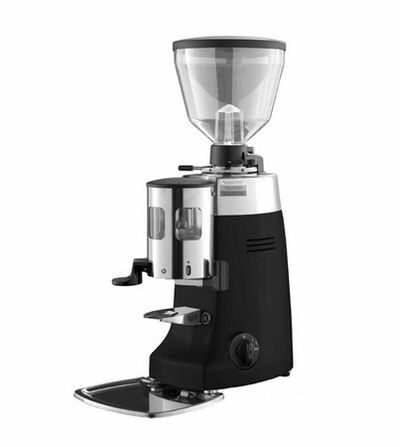Difference between revisions of "Mazzer Kony"
From Whole Latte Love Support Library
| Line 1: | Line 1: | ||
| − | The Mazzer Kony is an [https://en.wikipedia.org/wiki/Burr_mill#Coffee_grinders electric burr grinder]. | + | The Mazzer Kony is an [https://en.wikipedia.org/wiki/Burr_mill#Coffee_grinders electric burr grinder] designed for heavy usage in a commercial setting. {{Description-Table |
|title = Mazzer Kony | |title = Mazzer Kony | ||
|machine_image = [[File:MAZZER_KONY.jpg|400px|none]] | |machine_image = [[File:MAZZER_KONY.jpg|400px|none]] | ||
| Line 12: | Line 12: | ||
== Machine Description == | == Machine Description == | ||
| − | {{ | + | The Mazzer Kony Coffee Grinder is the grinder for a high volume espresso shop. With its 63 mm. conical burr grinder, which spins between 420 and 500 rpm. The Mazzer Kony Coffee Grinder features an adjustable doser that will dispense between 5.5 and 9 grams of coffee with the pull of a lever. This makes for simple and consistent operation. Its simple controls mean employees of various experience levels can operate it with ease; The stepless micrometrical adjustments are easy to change using the grinding adjustment disk right below the hopper. The Kony also features an attractive durable aluminum housing, allowing it to match almost any décor. The Mazzer Kony Coffee Grinder has an automatic grinding cycle that will start the grinder every twelve doses and stop the grinder when it reaches the desired amount. This ensures that there is always a supply of freshly ground espresso waiting and available for your customers, even at the busiest of times. |
| + | |||
| + | |||
| + | ==Getting Started== | ||
| + | ===Adjusting Grind First Time=== | ||
| + | |||
| + | When setting up the machine for the first use the grind should be set to a coarse setting before adding beans into the hopper. Starting the grind out on a fine sitting can result in the grinder becoming blocked or the beans not feeding into the machine properly. In extreme cases, where the burrs are set close enough to touch each other, it can strain the motor and damage the machine. | ||
| + | |||
| + | Once the grinder is set to a coarse setting beans can be added into the hopper. Adjustments in the fine direction should only be made while the burrs are grinding to prevent jams or damage to the burrs or motor assembly. | ||
| + | |||
| + | ===Seasoning The Burrs=== | ||
| + | |||
| + | If the grinder is new, or the burrs have been recently replaced, the grinder will need to be seasoned. New burrs need time to wear in to a point where they will perform consistently. For most machines it will take at least 4-6 lbs. of coffee for the burrs to become properly seasoned. Conical burrs will take more time to be seasoned than flat burrs. | ||
| + | {{#ev:youtube|https://www.youtube.com/watch?v=NwXXO_FZj9I|480|center}} | ||
| − | |||
== Cleaning & Maintenance == | == Cleaning & Maintenance == | ||
Revision as of 14:14, 16 May 2016
The Mazzer Kony is an electric burr grinder designed for heavy usage in a commercial setting.
| Mazzer Kony |
|---|
| Manufacturer: Mazzer |
| Model Name: Kony |
| Type: Electric burr grinder |
Contents
Machine Description
The Mazzer Kony Coffee Grinder is the grinder for a high volume espresso shop. With its 63 mm. conical burr grinder, which spins between 420 and 500 rpm. The Mazzer Kony Coffee Grinder features an adjustable doser that will dispense between 5.5 and 9 grams of coffee with the pull of a lever. This makes for simple and consistent operation. Its simple controls mean employees of various experience levels can operate it with ease; The stepless micrometrical adjustments are easy to change using the grinding adjustment disk right below the hopper. The Kony also features an attractive durable aluminum housing, allowing it to match almost any décor. The Mazzer Kony Coffee Grinder has an automatic grinding cycle that will start the grinder every twelve doses and stop the grinder when it reaches the desired amount. This ensures that there is always a supply of freshly ground espresso waiting and available for your customers, even at the busiest of times.
Getting Started
Adjusting Grind First Time
When setting up the machine for the first use the grind should be set to a coarse setting before adding beans into the hopper. Starting the grind out on a fine sitting can result in the grinder becoming blocked or the beans not feeding into the machine properly. In extreme cases, where the burrs are set close enough to touch each other, it can strain the motor and damage the machine.
Once the grinder is set to a coarse setting beans can be added into the hopper. Adjustments in the fine direction should only be made while the burrs are grinding to prevent jams or damage to the burrs or motor assembly.
Seasoning The Burrs
If the grinder is new, or the burrs have been recently replaced, the grinder will need to be seasoned. New burrs need time to wear in to a point where they will perform consistently. For most machines it will take at least 4-6 lbs. of coffee for the burrs to become properly seasoned. Conical burrs will take more time to be seasoned than flat burrs.
Cleaning & Maintenance
Burr Cleaning & Calibration
The grinder should be taken apart for cleaning and calibration every 25 lbs of coffee or every 6 months, whichever comes first. The burrs will slowly move out of calibration with use, and coffee residues and grounds will collect over time and create stale flavors.
Troubleshooting
Machine Not Powering On
- First plug the machine into another outlet. Make sure the machine is the only device on the outlet, and that the outlet works with other appliances.
- Try backing out the grind to a coarse setting. If the burrs are too close together they will not be able to move.
- Try using the machine on a different outlet, and make sure the machine is the only appliance plugged into that outlet.
- If the machine still is not working then there may be a loose wire internally.
- Once the machine is powering back on, reassemble the grinder and make sure the grind is set to the coarsest setting. Add beans back in and test the machine.
- If the beans grind correctly on this setting slowly move the grind setting to the desired position. Only adjust the grind size while the grinder is running or you risk jamming the grinder or blowing out the fuse again.
Motor On But Beans Won't Grind
If you hear the motor activating but there is nothing being ground, then the burrs are blocked. Make sure not to use oily, caramelized, or flavored beans in the grinder if you are going to be using the grinder for an espresso grind. These types of beans have a lot of sticky residues that can cause jams. Damage caused by use of these beans is often not covered under warranty.
- If the machine is set to a very fine grind, then the burrs may be touching each other. Back the machine off to the coarsest grind setting and see if it's able to grind.
- If the machine is able to grind on this setting, then the burrs were most likely too close together, or the grinder was adjusted when it was off. Try moving the grind back down slowly while the grinder is running. Adjustments should only be made while the grinder is running to prevent jams. Do not set the grind too fine; if the grind is in the Turkish range, like baby powder, then it is set too fine and the machine could jam again.
- If the machine is not able to grind on this setting, then there is a more serious jam. Please refer to the cleaning and maintenance icon above for instructions on burr cleaning and calibration. Once the grinder is cleaned and calibrated, it is important that the machine is set to a coarse grind before using it again. Setting the grind to a fine grind can cause it to jam again.
Grinds Coarse/Inconsistent
- If the machine is on a fine setting and the grinds are still coarse, or if the machine is producing grinds of all different sizes, then the grinder is out of calibration or needs to be cleaned. Please refer to the cleaning and maintenance icon above for instructions on burr cleaning and calibration.
- Oily, caramelized, or flavored beans can cake up on the burrs and push them out of calibration, so these beans should be avoided.
- Additionally adjustments to the grind fineness should only be made while the grinder is running. Moving the burrs closer together for a fine grind will cause them to press against any bean fragments or grinds already in the grinder.
- If the burrs are moving, those fragments get ground up and brushed aside.
- If the burrs aren't moving, then they will press into those fragments and cause the burr to get pushed out of alignment.
- Additionally adjustments to the grind fineness should only be made while the grinder is running. Moving the burrs closer together for a fine grind will cause them to press against any bean fragments or grinds already in the grinder.
- If the grinder is older, or if something was put through the grinder that is not meant to be put in it, the burrs may be worn out. If cleaning and calibrating the grinder is not resolving the behavior then it may be time to replace the burrs.
Diagrams & Manuals
| Electrical Diagram: | |
| Machine Manual: | |
| Parts Diagram: | |
| Service Manual: | |
| Startup Guide: | |
Specifications
| Basic Specs | |
|---|---|
| Width: | 8.1 in. |
| Height: | 24.4 in. |
| Depth: | 16.5 in. |
| Weight: | 44 lbs |
| Wattage: | 350 |
| Housing | |
| Housing Materials: | Aluminum |
| Bean Hopper Material: | Plastic |
| Frame: | Black Aluminum |
| Usage | |
| Grind Selection: | All Grinds |
| Recommended Applications: | High Volume Shop |
| Components | |
| Grinding Method: | Burr |
| Burr Type: | Conical |
| Burr Material: | Steel |
| Burr Size: | 63 mm |
| Capacity | |
| Bean Hopper Capacity: | 46 oz |
| Dispensing | |
| Dosing Options: | Doser |
| Doser Adjustability: | 5.5-9 grams |
| Controls | |
| Number Of Grind Settings: | Infinite |
| Programmable Grinding: | Yes |
| Display Type: | Digital |
| Controls: | Knobs / Switches |
| Step Type: | Stepless |
| Performance | |
| RPM: | 420-500 Burrs |

